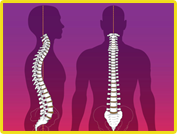

Structural therapy includes massage, bodywork, chiropractic, osteopathic, and other methods. These therapies are used to organize the body by relaxing muscles, aligning bones, freeing joints and flowing fluids. The principle of structural therapy is viewing the body as an integrative unit and aligning the body with gravity.
A structural therapist may work with any of the following systems of the body:
There are 206 bones in the human body. Bones can be divided into 2 categories--the axial skeleton and the appendicular skeleton
The axial skeleton is composed of the skull, vertebral column, and the thorax (12 pairs of ribs and the sternum). The appendicular skeleton is composed of the pectoral girdle, upper limbs, pelvic girdle, and lower limbs.
The skeleton serves vital functions such as :
Bone is composed of inorganic salts (primarily calcium and phosphate) that are embedded in an organic framework, which is made primarily of collagen fibers that gives the bone its tensile strength. It is this strength that keeps bones from twisting and stretching. In response to new stress, the collagen fibers exquisitely align their fibers to provide the maximum tensile strength.
Compressive forces are accommodated by the the inorganic salts. When stress is not applied to the bone or the bone is immobilized, the inorganic salts are leeched out of the bones, causing degeneration.
The two major stresses placed upon bones are gravity and functional forces. Gravitational stress results from supporting the body's weight For example, an obese person's skeleton becomes thicker due to the need to support a heavier weight. The functional forces occur when contracting muscles pull on bones. A person who lifts weights regularly will develop a heavier skeleton.
Bones depend on gravitational and functional stresses to maintain their strength. If these stresses are absent for an extended period of time, bones will begin to degenerate. When stresses are present, the continuous deposition of collagen and salts keeps the bones strong and healthy.
The nervous system is the controller of our organs, our senses, our movements, our thoughts, and emotions. It is the communicator-- our connection from our inner to our outer world.
The nervous system is divided in to central and peripheral nervous system. The central nervous system consists of the brain and the spinal cord. The peripheral nervous system includes 12 pairs of cranial nerves (situated in the brain) and 31 pairs of spinal nerves which arise from the spinal cord. These nerves are divided into two primary functional categories: sensory (feeling), and motor (movement). The peripheral nervous system also includes the autonomic nervous system that controls our internal organs. For example, it is the autonomic system that increases our heart rate when we are under stress.
The meninges consist of three layers of connective tissue that cover the brain and spinal cord:
The subarachnoid space is located in between the middle arachnoid layer and the pia mater. Cerebrospinal fluid is contained within the subarachnoid space. The cerebrospinal fluid bathes and protects the entire central nervous system. It is formed from blood, and returns to the bloodstream after circulating through the central nervous system. There exists a rhythmic pulse for this fluid (see Cranio-Sacral therapy).
There are 656 muscles in the human body -- and most of them have latin names. Muscles are exquisitely tailored for movement and force. They do not push, but can pull.
The inside of a muscle resembles a telephone cable -- large bundles are made up of smaller bundles. The smallest muscle strands, called myofibrils, contain interlaced filaments of protein. In fact, muscles are made mostly of protein. Contraction of myofibrils produces the force needed for movement.
Muscle movement is not just a consequence of the contraction of its fibers but also is determined by the arrangement of the muscle components. On an average there are about three muscles attached by tendons to every bone. The motor nerves of the peripheral nervous system link muscles to the spinal cord and brain. Nerve impulses cause the muscle to contract to to one-third of it's length.
There are three types of muscles: cardiac, smooth, and skeletal. Cardiac muscle is found only in the heart. It actually is a combination of smooth and striated muscles. Smooth muscle, also called involuntary muscle, lines blood vessels, the digestive tract, and other internal organs. Skeletal muscle, also known as voluntary, or striated, muscle, provides the force needed to move our limbs and other parts of the body.
Structural therapy is primarily concerned with the structure and function of skeletal muscles. There is a striking difference in the average amount of muscle mass in human females and males. In females, 23% of the body weight is skeletal muscle; in males, skeletal muscle makes up 40% of the body weight.
Tendons are strong inelastic fibrous tissue that connect muscle to bone.
Ligaments consist of a sheet of strong fibrous tissue that connects or anchors bone to bone.
One word comes to mind -- ubiquitous. Connective tissue is found everywhere in the body. This is the glue that holds us together, hence its name.
Connective tissue is the most abundant of all tissues in the body. It's main function is to support and bind other tissues. Connective tissue comes in various forms and serves many different functions. It is classified according to it's make-up as well as the organization of it's fibers. For example there is loose and dense connective tissue. Some connective tissue stores fat, some produces blood cells, and some produces antibodies to protect against disease.
Certain types of massage and bodywork, such as Structural Integration and Myofascial release, work specifically on connective tissue.
The circulatory system includes the heart, veins, arteries, and smaller blood vessels. The main function of this system is to provide oxygenated blood (carried by arteries) to every cell in the body and to remove deoxygenated blood (transported by veins) to the lungs. The circulatory system delivers the nutrients that every cell needs to survive. Stagnation of blood flow can result in unhealthy functioning of the body.
In traditional Swedish massage, strokes are always towards the heart -- to increase the effectiveness of the circulatory system.
Most of us know little about the lymphatic system, yet it is significant for life. It resembles the circulatory system in its functions. Lymph is derived from blood plasma but more watery than the plasma. Most soft tissue is bathed in lymph fluid.
The lymphatic system includes lymph fluid, lymph ducts, lymph nodes or glands (a majority in our necks), tonsils, thymus, and our spleen, which is the body's largest lymphoid tissue. The lymphatic system has several functions: As the body's defense system, it manufactures white blood cells and antibodies that combat disease-causing organisms. It is important for distribution of nutrients and fluids, and drains off excess fluids and proteins so our tissues do not swell. Lymph moves by using nearby arteries and muscles that contract and expand to exert pressure.
When the lymph system in not functioning properly, lymphatic massage can be very effective.
The viscera, or the internal organs, are mostly found in the abdominal and thoracic cavities. They are held in position by ligaments. In order to function properly, these vital organs must maintain their subtle mobility.
Visceral manipulation along with acupunture can be very effective in restoring the functioning of internal organs.
Skin is waterproof and protects our internal parts. It regulates our body temperature through shivering and sweating, and it kills some types of harmful bacteria.
Special sensory receptors in the skin -- both deep and superficial enable us to touch, sense vibrations and temperature, and feel pressure. In other words, it is our skin that allows us to maintain contact with the outside world.
Touch has been shown to be vital in a infant's development. In one U.S. study, it was found that babies who were not touched became less active, gained weight more slowly, and cried more often.
Touch is not only vital for babies but for adults as well. To touch and be touched is an essential factor for our emotional well-being.